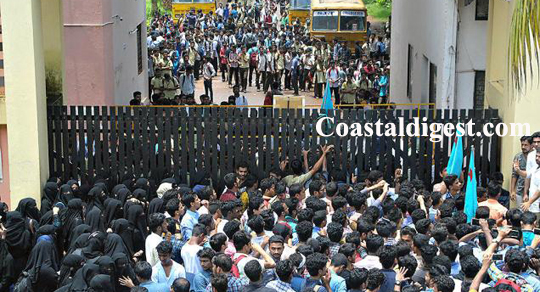Mangaluru, Aug 28: The protest by Campus Front of India (CFI) and parents of some of the students, has forced the Srinivas College of Pharmacy, located at Valacchil on the outskirts of the city, to relook into its recent decision to disallow Muslim girls to wear headscarf inside the classroom.

Dozens of Muslim students of the college on Saturday had boycotted the classes and joined the protest organised by the CFI at the entrance gate of the college demanding to allow Muslim girls to observe hijab (covering whole body except face and hands) and end alleged discrimination against them.
The college had recently barred first year B.Pharm students from wearing headscarves inside the classroom, library, office room, and exam hall. It also restricted students from wearing jeans and t-shirt. The first-year students and parents had signed a declaration at the time of admission.
On Thursday, a female student wearing hijab in the classroom was questioned by members of the college discipline committee. On Friday, activists of CFI came to the college and demanded that she be allowed to wear the hijab. The college principal reportedly told them that he can only act on a representation of students and their parents. On Saturday, the activists launched a protest, with some students joining in.
As the news began to spread, the college management reportedly assured the protesters to exclude restriction on hijab from the declaration and asked them to end the protest. A CFI delegation later met A Srinivasa Rao, the vice-president of A Shama Rao Foundation that runs the college. Mr Rao said there will not be any objection to students entering classes with hijab. A committee will re-look the code of conduct, he added.
Dr A R Shabaraya, the principal of the college, later told media persons that the students and parents had gone through the declaration form before submitting it. He said 800 students are pursuing their pharmacy courses in the college. As the declaration forms were not collected from second and fourth semester students, they were allowed to wear head-scarfs, he said.
There is no restriction on wearing headscarf and moving around in the college campus. "The dress code is being imposed for the last one month in the college. Some students wore headscarf while entering the classrooms two days ago. But they were not sent out of classes. No students have given any representation to the college authorities seeking permission to wear headscarf," he clarified.
Meanwhile, in a memorandum, the CFI also urged the college authorities to change the timings of the classes on Fridays to benefit the Muslim students to attend the juma prayers.
Also Read: Muslim students protest against Srinivas College for 'hijab ban'




Comments
15# f amber moral police never shut up their mouth till get good punishment.
#shamshuddin hey bro when babri masjid was demolished any kind of org like PFI,KFD is there o what so many crisis were happened before popular front forming in india then why don't the govt not controlled. please shut up and don't be show off k we know what is PFI insha allha ham honge kamiya ek din.....
aharkul #13 dear, Fighting for Justice? if you real fight with Justice go to management or principal request to solve the problem if they are not agree , students and parents is the responsible. moral activities? no never in Islam.
Dear Mr. Shamsuddin
They are fighting for justice. So what is the problem wearing Hijab or headscarp in the class room. Why you are not supporting them?
India is a secular country...be like that way...no one can impose dressing code on anyone.....religious freedom should be upheld....immoral or ugly way of dressing, of course that should be stopped....
H0nest Poeple never hide their own Names
Dear h0nest, #9
What common sense u r talking about, teach students to study 1st. Not politicise , college administration and parents will solve the problems , why flags!!! Shame on u guys following RSS tricks
Dear Shamshuddin #5
Have some common sense and logic
One is fighting for the rights of the poor and oppressed and the other is fighting to the Take the rights of the poor and the oppressed.
All Institutions & universities should keep in there objectives that they should not violate individuals Constitutional Rights.....!!!!!
Mr. naren and his team received burnool baghya....
Well done CFI.
@Sinan, please read news once again and then decide what to comment. :)
Campus Front and KFD-IFF all same , following RSS-BD-SRS-ABVP culture.. should ban all those organizations. Otherwise hindu muslim riots will never End.
Thanks to the students Organization . It's good work done.
We have to respect the institute and the Principal and teaching staff.
Whatever agitation may be, it should be peaceful and with respect.
Also you should deal with the Princepal or authority in a very respect way. Whatever their reaction may be.
At the end they are our teachers and the teachers are same as our parentsl.
At last VICTORY is always ours. Whether it is in this world or life after Death.
Good move by the management.
ISLAM says it is better for women to cover their body
And we see now a days many rapes are happening around us.
Its a divine revelation that women should cover themselves for their better respect and honour in the society...
Those who reject divine message will surely a would be victim to culprits like rapist and molesters
Srinivas management should study Why ISLAM & Christianity or some sects of Hindus Women cover and what their religious scriptures says before banning them... That's intelligence when U study and learn about the subject...
Falling to media pressure or cheddi pressure will dump you in future.
College had clearly stated that they would allow to wear hijab if the girl student and her parents formally request. Then why did CFI stage protest? Just for cheap publicity?
Add new comment